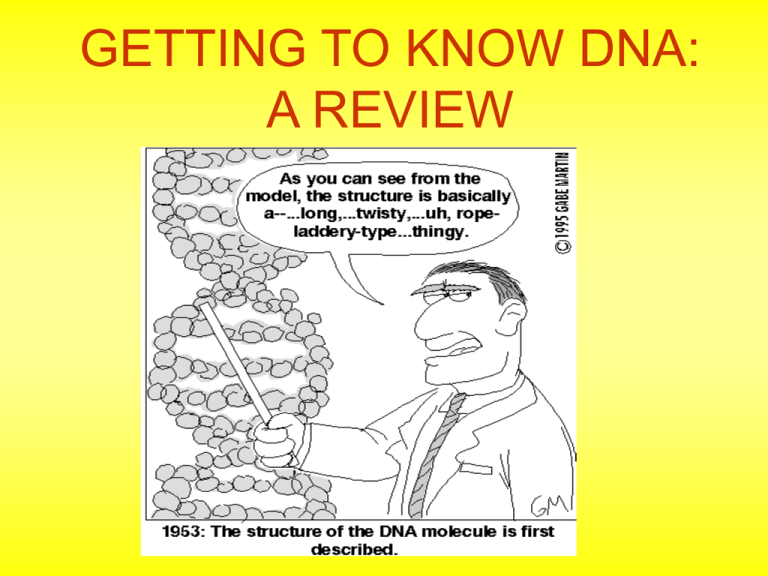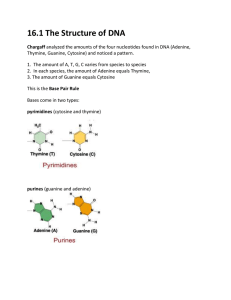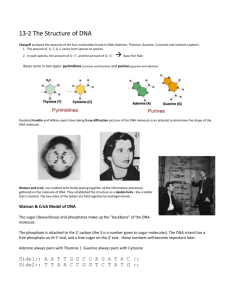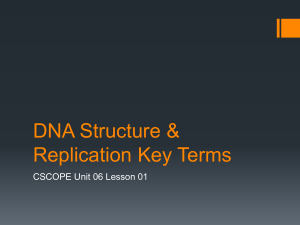DNA - Solon City Schools
advertisement

GETTING TO KNOW DNA: A REVIEW As you know, DNA stands for…. DEOXYRIBONUCLEIC ACID Is DNA a monomer or polymer 1. Monomer 2. Polymer What does it mean to be a monomer? What does it mean to be a polymer??? If we were reviewing proteins, the monomer units would be: 1. 2. 3. 4. Nucleic acids Fatty acids Sugars Amino acids If the monomer units of proteins are amino acids, the monomer units of DNA are known as…. NUCLEOTIDES All nucleotides have three “parts” in common. They all contain…. One of FOUR different NITROGEN BASES Phosphate Group Sugar= Deoxyribose I am sure you recall, we used our hands to represent a nucleotide. PHOSPHATE NITROGEN BASE SUGAR The four different Nitrogen Bases for DNA are abbreviated using the following letters…. A Adenine T Thymine G Guanine C Cytosine Using your two hands, please show how you think two nucleotides will/should bond together. Did you put your hands like this??? Time to find out why this is wrong!!! Adenine and Guanine are larger molecules known as… PURINES LOOK! TWO RINGS!!! THYMINE and CYTOSINE are smaller molecules known as… PYRIMIDINES LOOK! Only one ring!! Now, when using our hands to represent the nucleotides, we must modify the nitrogen base in order to represent these PURINES and PYRIMIDINES. How would you represent a large PURINE? How would you represent a small PYRIMIDINE? Full Finger Half Finger In DNA, a PURINE always bonds with a PYRIMIDINE when forming a “rung” of the DNA ladder. LOOK! A long finger pairs with a short finger! In other words, a purine pairs with a pyrimidine. In DNA, Adenine always pairs with Thymine using two hydrogen bonds. A T In DNA GUANINE always pairs with CYTOSINE using three hydrogen bonds. G C Time to use your brain and hands in order to review nucleotide structure and type. OK Now that you recognize nucleotide type and structure, it’s time to start building the polymer from these monomers. The molecules marked “W” are best described as: 1. 2. 3. 4. Monomers Polymers Isomers isotopes Reactions A and B are respectively known as: A 1. 2. 3. 4. Dehydration, hydrolysis Condensation, hydrolysis Polymerization, decomposition Hydrolysis, dehydration B Molecule(s) “X” are most likely: 1. 2. 3. 4. 5. Carbohydrates Monomers Polymers Water Starch If molecule “W” is a nucleotide, molecule marked “Y” is most likely: 1. 2. 3. 4. 5. Protein Starch DNA Galactose Fructose In order to make a molecule of DNA, you would need to create many rungs to the DNA ladder. Look. Many Rungs. Etc… What part of the nucleotide alternates to form the sides of the DNA ladder? Sugar, Phosphate. Sugar, Phosphate. Sugar, Phosphate. Etc… Etc… What makes up the “RUNGS” of the ladder? The Nitrogen Bases Go Ahead! Stack you hand on top of your partners hands building two rungs of the DNA ladder. Why is this WRONG???? The sides of the DNA ladder “run” in opposite directions. One side is actually flipped and the nucleotides are upside down! TRY IT!!! Because the sides of the DNA “run” in opposite directions, DNA is said to be ANTIPARALLEL. In this DNA molecule, the THUMB part or better known as the PHOSPHATE GROUP, is said to be the 5 prime (5’) end. 5 prime 5 prime The “hand” or sugar part of the DNA molecule makes up the 3 prime (3’) end of the DNA ladder. 3 Prime 3 Prime If you link enough nucleotides together, the DNA molecule begins to take on the characteristic shape known as the Double Helix Let’s Build Some DNA!! You Need… •Two Pipe cleaners •Two red twizzlers •Two black twizzlers •Many toothpicks •Four different colored marshmallows The marshmallows represent the nitrogen bases. Let’s decide as a class what colors will represent the following nitrogen bases. ADENINE= CYTOSINE= THYMINE= GUANINE= Person One Cut the black twizzlers into 1.5 cm pieces. These will represent the phosphate groups Person Two Cut the red twizzlers into 3 cm pieces. These will represent the sugars. Add the twizzlers to the pipe cleaners. Remember, you need to alternate SUGAR (red) AND PHOSPHATE GROUPS (black). When you are finished, your strand should not end in the same color you started with! Did you and your partner make the same number of nucleotides on the sides of your ladder? If not, FIX IT!!! Time to put together the two sides. Using the toothpicks and marshmallows, you are to add the nitrogen bases to the sides of the ladder. Remember, the nitrogen bases “come off” the sugar part of the nucleotide. As a result, they should be coming off of the red twizzler. Please use two of the same color marshmallows to represent one ADENINE and GUANINE. The BIG purines. Please use only one marshmallow to represent THYMINE and CYTOSINE. The small pyrimidines. Following your teachers directions, let’s build one long strand of DNA A Particular strand of DNA contains 10 adenine molecules. How many thymine will it contain: 1. 2. 3. 4. 5 10 20 Not enough information A strand of DNA is 20% Guanine molecules. What is the percent of thymine in the strand of DNA? 1. 2. 3. 4. 5. 10 20 30 40 Not enough information A particular strand of DNA is 40% guanine. What is the percent of adenine in the same strand? 1. 10 2. 20 3. 30 4. 40 The molecule at the location identified by the arrow: 1. 2. 3. 4. 5. Adenine Guanine Sugar Phosphate thymine The molecule at the location identified by the arrow: 1. 2. 3. 4. 5. Adenine Guanine Sugar Phosphate thymine The molecule at the location identified by the arrow: 1. 2. 3. 4. 5. Adenine Guanine Sugar Phosphate thymine The end of the molecule identified by the blue arrows: 1. Five prime 2. Three prime The end of the molecule identified by the red arrows: 1. Five prime 2. Three prime Because the sides of the DNA ladder run in opposite directions, DNA is said to be… 1. 2. 3. 4. Parallel Nonparallel Antiparallel proparallel What is a GENE? Stay Tuned!! We will answer this question tomorrow.






